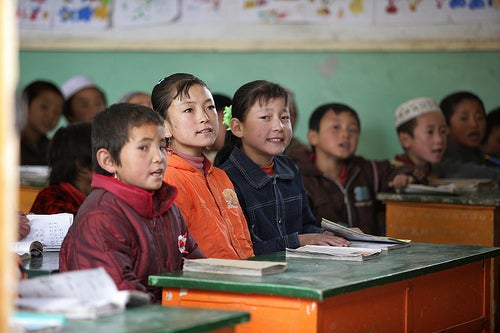Click here to view the full Infographic in high resolution.
Tomorrow, a Learning for All Ministerial Meeting will bring together development partners and ministers of finance and education from Bangladesh, the DRC, Ethiopia, Haiti, India, Nigeria, Yemen, and South Sudan – home to nearly half of the world’s out-of-school-children – to address challenges and steps to ensure that all children go to school and learn.
Together with the Global Partnership for Education, we launched a social media campaign and asked our online audience to share ideas around the four questions that ministers and development partners will discuss at the meeting:
1.What will it take to get all children in school and learning?
2.What are the most serious bottlenecks to getting all children in school and learning?
3.What are priority actions for governments to achieve learning for all?
4.What can development partners do to help ensure all children are able to go to school and learn?
We received over 150 responses from across the world, which came in through various social media channels. Listed below are few of the ideas we crowd-sourced through this campaign. You can read the full set of online responses here and here.
It is not too late to contribute to the conversation! Watch the live webcast of the Ministerial meeting at 4:45pm EDT / 8:45 pm GMT tomorrow or follow the proceedings @WBG_Education using #educationfirst.
What will it take to get all children in school and learning?
 Heather Freitag: Quality teachers, smaller class sizes & innovative teaching methods will help kids learn.
Heather Freitag: Quality teachers, smaller class sizes & innovative teaching methods will help kids learn.
Ibba Girls School: Gender equality & stopping girls being forced into marriage at very young ages in developing countries.
Charlotte Phillips, Kigali, Rwanda: It’s one thing to get children into school (making it compulsory, waiving fees and providing school meals help with this) but another to get them to learn while there. For that it’s all about the teachers. Pay teachers a living wage. This will attract more people into teaching and reduce class sizes, as well as allowing teachers to hold their heads high and gain the respect of the communities they serve in.
What are the most serious bottlenecks to getting all children in school and learning?
 Rutwik J. Gandhe: Quality of Education in rural / remote areas is a major constraint for getting children into school.
Rutwik J. Gandhe: Quality of Education in rural / remote areas is a major constraint for getting children into school.
Rob Gateru, Kenya: It is difficult to have a universal solution since what may work in one country may not work in another. It is important to understand the unique challenges of each setting. In my own humble assessment, the main barriers are poverty, ignorance (especially on the side of parents), cultural beliefs and practices, poor infrastructure and poor government policies/lack of political will to address such matters.
Abu Mubarik , Ghana: The opportunity cost for parents sending children to school is the children’s time that could have been of economic importance to the family either in the form of income generating activities or in supporting the functioning of the house. If the world is going to make any meaningful impact on getting every child to school, critical factors must be considered. For instance, the child must be motivated with incentives to make schooling exciting. Cost of schooling like cost of books, PTA fee, sports fee, extra-tuition fee, mid-term fee, school uniform and exams fee, which most often hinders the child’s interest in education, should be turned into incentives, to boost her interest in school.
What are the priority actions for governments to achieve learning for all?
 Noor Akbar: No rocket science! Gov’ts need to do only 2 things to achieve learning for all: Give top priority and allocate ample funds for it.
Noor Akbar: No rocket science! Gov’ts need to do only 2 things to achieve learning for all: Give top priority and allocate ample funds for it.
Behailu , Ethiopia: The government has to incorporate social accountability in its governance structure in order to ensure that ‘education for all!’ is in place. This is because without the full engagement of citizens, it’s almost impossible to implement and achieve the policy objectives. The community knows everything in its area and they are very logical and practical in their decision making. At the same time we can for sure mobilize the necessary resource needed to solve the problem with in their vicinity. Let’s approach them! Let’s listen to them! Let’s work with them! Let’s engage them in all phases of the development agendas!
What can development partners do to help children go to school and learn?

Zulfi Khan:Educate 10 million mothers and the rest will be looked after by them
Fatima Sada, London, UK :Development partners should support governments to plan and implement quality education. Government at all levels must increase their investment in quality and access in basic education.


Join the Conversation